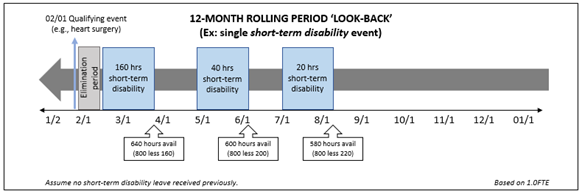1. How does the University define a year?
The year is defined as the 12 months measured backward from the date an employee uses a qualifying leave. With this "rolling" method, each time an employee uses short-term disability, the remaining balance of the applicable leave which has not been used during the immediately preceding 12 months is the available leave. An example of how the new calculation method works is below: Example:
2. What happens if an employee has multiple qualifying events within 12 months?
Employees must apply for short-term disability with each new qualifying event. If the situation is approved as a serious health condition for short-term disability purposes, the remaining balance of the applicable leave which has not been used during the immediately preceding 12 months is the available leave. Example:
3. If an employee has a break-in-service, does the rolling period start over again to establish the available leave balance?
No. If an employee has a break in service, the short-term disability received in the preceding 12 months, including before the break, counts towards the 12-month rolling period.
4. For whose illness can short-term disability leave be taken?
An employee may take short-term disability leave for their own serious health condition.
5. How is “serious health condition” defined for purposes of short-term disability leave?
A serious health condition is defined according to the FMLA definition, including an illness, injury, impairment, or physical or mental condition that involves: Inpatient care, such as an overnight stay in a hospital, hospice, or residential medical care facility or any subsequent treatment in connection with such inpatient care, or continuing treatment by a health care provider. See HR-407.
6. Can a supervisor deny short-term disability leave?
No. If an employee meets the qualifications for short-term disability, the employee will be offered the available paid time off. Employees are encouraged to work with their supervisor to plan for anticipated time off due to a qualifying leave.
7. How often does the elimination period need to be met?
The elimination period must be met for each new serious health condition for which short-term disability benefits are being applied. If a re-occurring or related serious health condition occurs for which an elimination period was previously met, a new elimination may not be required depending on the successive period parameters. Contact the University of Missouri System Human Resources Leave Administration team for more details.
8. What pay is available to cover the additional 40% that short-term disability does not pay?
Employees may purchase additional short-term disability insurance during annual enrollment to 'top-off' the employer paid short-term disability pay. If employees do not have the extra insurance, available accrued time off is used to cover unpaid time associated with short-term disability in the order of: sick, PTO, and then vacation. Once all available paid leave is exhausted, the remaining 40% is without pay.
9. What is the effect of holiday and/or winter break pay when an employee is on leave?
Employees are eligible to receive holiday pay and winter break pay, if eligible, when on a paid leave of absence. In addition, short-term disability hours available will not reduce when receiving holiday or winter break hours.
10. What is Annual Base Benefit Rate (ABBR)?
ABBR is the base rate of employees’ earnings (e.g., their hourly rate of pay). It includes income before pre-tax contributions are made to flexible spending accounts or deferred compensation plans. ABBR does not include other income received such as overtime pay, shift differentials, incentive payments, or employer contributions to retirement plans.
11. If I have a pre-existing condition, will short-term disability benefits be available?
Possibly. To be considered for short-term disability benefits, eligible employees must meet all applicable qualifying criteria, including the condition is considered a serious health condition, and the employee meets the elimination period while employed in an eligible position with the University. Disability Benefit Payments under this Plan may be paid for qualifying medical disability leaves which occur on or after January 1, 2024, pending all other eligibility requirements.
12. Is an employee eligible for short-term disability leave even if they are not eligible for FMLA?
Yes. Eligibility for short-term disability leave does not require an employee to be eligible for FMLA. While many of the policy elements are the same, such as the definitions of a serious health condition, an employee may be approved for short-term disability leave pay even if they are not yet eligible for or have exhausted available leave under the Family and Medical Leave Act (FMLA).
Date Effective: Posted 10-01-2023 with an effective date of 01-01-2024
Date Revised:
Reviewed 2023-10-02